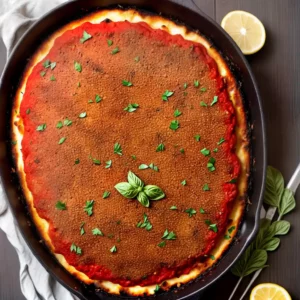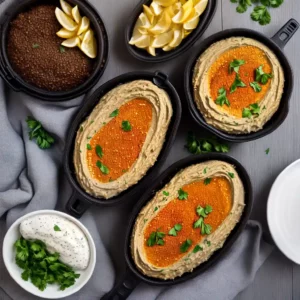Hello, fellow food enthusiasts! Today, I’m excited to share with you the best methods for reheating stuffed shells to ensure they retain their delicious flavor. Whether you have leftover stuffed shells from last night’s dinner or you simply want to prepare them in advance for a future meal, reheating them properly is key to enjoying that same mouthwatering taste. So, let’s dive in and discover how to reheat stuffed shells for the best flavor!
Key Takeaways:
- Reheating stuffed shells in the oven is the recommended method for achieving the same great flavor and texture.
- Preheat the oven to 375°F, cover the shells with foil, and heat for about 25 minutes until the internal temperature reaches 165°F.
- Reheating on the stovetop or in the microwave can also work but may result in slightly different textures.
- Store leftover stuffed shells in an airtight container in the refrigerator for 3-5 days.
- Thaw frozen stuffed shells before baking for better texture and even cooking.
Reheating Stuffed Shells in the Oven
If you want to enjoy the best flavor and texture when reheating stuffed shells, the oven is the way to go. Preheating the oven to 375°F and using an oven-safe dish ensures even heating and keeps the cheese and filling intact.
Here’s a step-by-step guide to reheating stuffed shells in the oven:
- Preheat the oven to 375°F.
- Place the stuffed shells in an oven-safe dish.
- Cover the dish with foil to prevent drying out.
- Heat the shells for about 25 minutes or until the internal temperature reaches 165°F.
This method helps retain the delicious flavor and texture of the stuffed shells, ensuring a satisfying meal every time. Plus, reheating in the oven allows for consistent heating throughout, giving you that fantastic baked goodness.
“Reheating stuffed shells in the oven is the best method to retain the flavor and texture.”
So, when you’re looking to enjoy those leftovers, turn to the trusty oven for the best reheating results. Your taste buds will thank you!
| Reheating Method | Pros | Cons |
|---|---|---|
| Oven | Retains flavor and texture | Takes longer |
| Stovetop | Can yield good results | Requires attention to prevent sticking |
| Microwave | Quick and convenient | May result in a rubbery texture |
Reheating Stuffed Shells on the Stovetop
When it comes to reheating stuffed shells, the stovetop method may not be the most common, but it can still be an effective way to retain flavor and moisture. This method is particularly useful if you prefer your shells to have a slightly al dente texture.
To reheat stuffed shells on the stovetop, you’ll need a large pan with a lid. Add a small amount of water to the bottom of the pan to create steam and prevent sticking. Place the stuffed shells in a single layer in the pan and cover it with the lid. Heat the shells on medium-low heat for about 5-10 minutes, checking occasionally to ensure they are not sticking to the pan. This gentle heating process helps maintain the flavor and moisture of the shells while keeping them tender and al dente.
While reheating on the stovetop may take a bit longer than other methods, it allows for more control over the reheating process and ensures that the shells are evenly heated. Just be sure to keep an eye on them to prevent any potential burning or sticking.
Pros and Cons of Reheating on the Stovetop:
| Pros | Cons |
|---|---|
| Retains flavor and moisture | Requires attention to prevent sticking |
| Keeps shells tender and al dente | Takes longer than other methods |
“Reheating stuffed shells on the stovetop gives me more control over the process and ensures that the shells maintain their flavor and al dente texture.” – Chef Doe
So, if you’re looking for a method that allows you to savor the flavors and moisture of your stuffed shells while keeping them al dente, the stovetop method can be a great option. Just remember to use a large pan with a lid, a little water to prevent sticking, and be attentive during the heating process. Enjoy your reheated stuffed shells with all their deliciousness intact!
Reheating Stuffed Shells in the Microwave
When it comes to reheating stuffed shells, the microwave can be a quick and convenient option. Simply place the stuffed shells on a microwave-safe dish and add a little extra sauce or water to prevent them from drying out. Cover the dish with a paper towel or microwave-safe cover to retain moisture, and then cook on medium heat for 1 minute at a time until the shells are heated through.
While the microwave method is convenient, it’s important to note that it may result in a slightly different texture compared to reheating in the oven or on the stovetop. The microwave can make the shells a bit rubbery, so be sure to keep a close eye on the texture as you reheat them. If you prefer a softer texture, the microwave method may be just right for you.
Although reheating stuffed shells in the microwave is quick, it’s worth considering the trade-off in texture. If you’re looking for the same great flavor and texture as when the shells were freshly baked, reheating in the oven is still the recommended method. However, if you’re in a hurry or don’t mind a slightly different texture, the microwave can be a convenient option for reheating your stuffed shells.
| Pros | Cons |
|---|---|
| Quick and convenient | Potential rubbery texture |
| No need to preheat | May require additional sauce or water to prevent drying out |
| Can be suitable for softer texture preferences | Not the best method for achieving the same flavor and texture as fresh |
Pros and Cons of Reheating Methods
When it comes to reheating stuffed shells, there are three main methods to choose from: the oven, stovetop, and microwave. Each method has its own advantages and disadvantages. Let’s take a closer look at the pros and cons of each.
Reheating in the Oven
Using the oven to reheat stuffed shells is generally considered the best method for achieving the same great flavor and texture as when they were freshly made. The gentle and even heat of the oven helps retain the integrity of the shells, ensuring that the cheese and filling stay intact. However, the downside of reheating in the oven is that it takes longer compared to other methods.
Reheating on the Stovetop
Reheating stuffed shells on the stovetop can yield good results as well. This method helps to retain the flavor and moisture of the shells, keeping them al dente. However, it requires attention to prevent sticking. By using a large pan with a lid and adding a little water to the bottom, you can create a steamy environment that heats the shells gently and evenly.
Reheating in the Microwave
If you’re short on time, reheating stuffed shells in the microwave can be a quick and convenient option. However, this method may result in a less desirable texture, making the shells rubbery. It’s important to keep an eye on the shells as they heat in the microwave to prevent overcooking. Adding a little extra sauce or water can help prevent drying out.
Pros and Cons Summarized
Here’s a summarized breakdown of the pros and cons of each reheating method:
| Method | Pros | Cons |
|---|---|---|
| Oven | Retains flavor and texture | Takes longer |
| Stovetop | Retains flavor and moisture | Requires attention to prevent sticking |
| Microwave | Quick and convenient | Rubbery texture possible |
Consider these pros and cons when choosing the best reheating method for your stuffed shells. Whether you prioritize flavor, convenience, or speed, there’s a method that suits your needs.
How Long Can Stuffed Shells Stay in the Fridge?
When it comes to storing leftover stuffed shells in the refrigerator, it’s essential to know how long they can safely stay fresh. Generally, stuffed shells can be stored in the fridge for 3-5 days if stored properly in an airtight container. This timeframe ensures that the shells remain safe to consume and maintain their quality.
However, it’s crucial to note that the countdown starts from the moment the shells are prepared and cooked. It’s best to refrigerate them within two hours of being left out at room temperature. This helps prevent the growth of harmful bacteria that can cause foodborne illnesses.
If you notice any signs of spoilage, such as mold growth or a bad smell, it’s crucial to discard the stuffed shells immediately. Consuming spoiled food can lead to food poisoning and other health risks. Therefore, always prioritize food safety when it comes to storing and consuming stuffed shells.
Proper Storage for Stuffed Shells
To ensure the longest shelf life for your stuffed shells, it’s important to store them correctly. After enjoying your meal, place the leftovers in an airtight container. This helps prevent moisture loss, which can affect the texture and flavor of the shells. Consider wrapping the shells tightly with plastic wrap or aluminum foil before placing them in the container for added protection.
| Storage Tips | Do’s | Don’ts |
|---|---|---|
| Use an airtight container | ✔️ | ❌ |
| Wrap shells tightly in plastic wrap or foil | ✔️ | ❌ |
| Keep shells away from strong-smelling foods | ✔️ | ❌ |
| Don’t leave shells uncovered in the fridge | ❌ | ✔️ |
How to Store Leftover Stuffed Shells
To store your leftover stuffed shells, follow these simple steps:
- Allow the shells to cool down to room temperature before storing.
- Place the shells in an airtight container, ensuring they are not overcrowded.
- Store the container in the refrigerator at a temperature below 40°F (4°C).
- Consume the leftover stuffed shells within the recommended 3-5-day timeframe.
By following these storage guidelines, you can enjoy your stuffed shells for several days without compromising their quality or risking foodborne illnesses.
How to Store Leftover Stuffed Shells
When it comes to storing leftover stuffed shells, proper storage is key to maintaining their freshness and flavor. The best way to store them is by placing them in an airtight container. This will help prevent moisture and odors from seeping in and compromising their taste. To further protect the shells, it is recommended to wrap them tightly in plastic wrap or aluminum foil before placing them in the container.
By storing the leftover stuffed shells in an airtight container, you can ensure that they stay fresh for an extended period. However, it is important to note that they should be consumed within 3-5 days to maintain optimal taste and quality. Be sure to check for any signs of spoilage before consuming them.
Proper storage not only keeps your leftover stuffed shells safe to eat but also allows you to enjoy them at a later time without sacrificing their delicious flavors. So, next time you have leftover stuffed shells, remember to store them in an airtight container to preserve their freshness and savor them whenever you desire.

Tips for Storing Leftover Stuffed Shells:
- Place the leftover stuffed shells in an airtight container
- Wrap the shells tightly in plastic wrap or aluminum foil before storing
- Store in the refrigerator and consume within 3-5 days
- Check for any signs of spoilage before consuming
What To Do With Leftover Stuffed Shells
When you find yourself with leftover stuffed shells, don’t let them go to waste! Get creative and explore different recipes to enjoy your stuffed shells in new and delicious ways. Here are some ideas to inspire you:
1. Topped with Sauce and Cheese
A quick and easy way to use leftover stuffed shells is to simply top them with your favorite sauce and cheese. Place the shells in a baking dish, cover them with extra sauce, sprinkle generously with cheese, and bake in the oven until heated through and the cheese is melted and bubbly. This creates a flavorful and satisfying meal in no time.
2. Add Ground Meat
If you want to create a heartier dish, consider adding some ground meat to your leftover stuffed shells. Brown some ground beef or Italian sausage in a pan, mix it with your preferred sauce, and stuff the mixture into the shells. Top with more sauce and cheese, and bake until everything is cooked through. This variation adds an extra layer of flavor and protein to your meal.
3. Creamy Spinach and Cheese Filling
For a unique twist on your leftover stuffed shells, try filling them with a creamy spinach and cheese mixture. In a bowl, combine cooked spinach, ricotta cheese, grated Parmesan, and seasonings of your choice. Stuff the shells with this mixture and place them in a baking dish. Pour some sauce over the shells, sprinkle with mozzarella cheese, and bake until heated through and the cheese is golden and bubbly. This filling is a delicious and vegetarian-friendly option.
With these creative ideas, you can transform your leftover stuffed shells into mouthwatering meals that everyone will enjoy. Don’t let those delicious shells go to waste!

How to Know If Stuffed Shells Have Gone Bad
When it comes to stuffed shells, it’s important to be able to recognize the signs of spoilage to ensure the safety of your meal. Here are some key indicators that your stuffed shells may have gone bad:
- The shells have started to soften or break down. If you notice that the shells have become mushy or are falling apart, it’s best to discard them. This can be a sign that the shells have become overripe and may not be safe to eat anymore.
- You see any mold growth on the surface. Mold is a clear indication of spoilage and can occur if the shells have been improperly stored or if they are past their expiration date. If you see any mold on the shells, it’s important to throw them away immediately.
- The filling has started to ooze out. If the filling of the stuffed shells has begun to leak or ooze out, it’s a sign that the shells have deteriorated and should not be consumed. This can happen if the shells have been stored for too long or if they have been exposed to improper conditions.
It’s essential to prioritize food safety when it comes to consuming stuffed shells or any other perishable food. If you notice any of these signs of spoilage, it’s best to err on the side of caution and discard the shells to avoid the risk of foodborne illness.

How Long To Cook Stuffed Shells
Cooking stuffed shells requires careful timing to ensure they are perfectly cooked but still retain a firm, al dente texture. The cooking time can vary depending on the size of the shells and the ingredients used in the filling. The key is to achieve a balance where the pasta is cooked through but not overly soft or mushy.
Generally, stuffed shells should be boiled in salted water for 8 to 10 minutes or until al dente. Al dente means the pasta is cooked to a firm, slightly chewy consistency when bitten. To test for doneness, carefully remove a shell from the boiling water and cut it in half. The center should still have a slight bite to it.
Once the shells are cooked, drain them well and cool them slightly before filling them with your desired mixture. Whether you’re using a traditional cheese and spinach filling or adding meat, the filled shells are typically placed in a baking dish, topped with sauce and cheese, and then baked in the oven until the cheese is melted and bubbly.
Table: Stuffed Shells Cooking Time
| Shell Size | Cooking Time |
|---|---|
| Small shells | 8-10 minutes |
| Medium shells | 10-12 minutes |
| Large shells | 12-14 minutes |
Remember, the cooking time provided is just a guideline, and you should always check the shells for doneness by taste testing. Overcooking can result in mushy shells, while undercooking may leave them too firm. With a little practice and careful monitoring, you’ll be able to achieve perfectly cooked stuffed shells every time.

Can Frozen Stuffed Shells Be Baked Without Thawing?
When it comes to reheating frozen stuffed shells, the question often arises: can they be baked without thawing? While it is possible to bake frozen stuffed shells directly, it is generally recommended to thaw them first for better results. Thawing allows the shells to soften slightly, ensuring a more even and tender texture throughout.
To thaw frozen stuffed shells, simply remove them from the freezer and transfer them to the refrigerator. Let them thaw overnight or for at least 8 hours before baking. This gradual thawing process helps to maintain the integrity of the shells and ensures a more enjoyable dining experience.
However, if you’re short on time and need to bake the frozen stuffed shells immediately, you can still do so. Preheat your oven to the recommended temperature, according to the original recipe or packaging instructions. Increase the baking time by approximately 10-15 minutes to account for the frozen shells.
Keep in mind that baking frozen stuffed shells without thawing may result in a slightly different texture compared to thawed shells. The outer layer may become more cooked while the inside might still be slightly frozen. It’s crucial to check for doneness by ensuring that the center reaches a safe internal temperature of 165°F (74°C).
In summary, while it’s possible to bake frozen stuffed shells without thawing, it’s generally recommended to thaw them first for a more consistent and enjoyable texture. Thawing overnight in the refrigerator allows the shells to soften gradually, resulting in a more evenly cooked dish. However, if you’re in a hurry, you can still bake them from frozen, but be sure to adjust the baking time accordingly.
Table: Pros and Cons of Baking Frozen Stuffed Shells
| Pros | Cons |
|---|---|
| Convenience – no need to wait for thawing | Potential uneven cooking |
| Quicker preparation time | Possible difference in texture |
| No additional steps required | Monitoring internal temperature closely |
How Many Times Can Stuffed Shells Be Reheated?
When it comes to reheating stuffed shells, it’s important to consider both food safety and optimal taste. While you can technically reheat stuffed shells multiple times, it’s recommended to reheat them only once to maintain the best flavor and texture.
Reheating stuffed shells repeatedly increases the risk of bacterial growth, which can lead to foodborne illness. To ensure food safety, it’s best to reheat the shells only when you plan to consume them immediately. This will help prevent any potential contamination and keep your meal safe to eat.
Additionally, reheating stuffed shells multiple times can affect their taste and texture. Each time you reheat the shells, they can become drier and lose some of their original flavor. Reheating them only once allows you to enjoy the optimal taste and texture of the dish.
So, while it may be tempting to reheat stuffed shells multiple times to minimize waste, it’s best to prioritize food safety and taste by reheating them only once. This way, you can savor the delicious flavors of your leftover stuffed shells without compromising on quality.
Summary:
- Reheating stuffed shells multiple times increases the risk of bacterial growth and can affect the taste and texture of the dish.
- To ensure food safety, it’s recommended to reheat stuffed shells only once before consuming.
- Reheating the shells multiple times can make them drier and less flavorful.
- Prioritize food safety and optimal taste by reheating stuffed shells only once.
Table: Pros and Cons of Reheating Methods
| Reheating Method | Pros | Cons |
|---|---|---|
| Oven |
|
|
| Stovetop |
|
|
| Microwave |
|
|
Conclusion
In conclusion, reheating stuffed shells can be done in different ways, but the best method for achieving the same great flavor and texture is reheating in the oven. Preheating the oven to 375°F, covering the shells with foil, and heating them for about 25 minutes ensures a delicious result. However, if you are short on time, the stovetop or microwave methods can also work, although they may result in slightly different textures.
Experiment with these methods to find your preferred way of reheating stuffed shells and enjoy them as a delicious leftover meal. Remember to consider the pros and cons of each method, including flavor, texture, and convenience. It is important to store and handle stuffed shells properly to maintain food safety and prevent spoilage.
Whether you choose to reheat in the oven, on the stovetop, or in the microwave, the key is to ensure the shells are heated evenly and the filling stays intact. By following the recommended reheating methods and taking into account the specific characteristics of each method, you can enjoy perfectly reheated stuffed shells with the best flavor and texture.
FAQ
How do I reheat stuffed shells for the best flavor?
The best way to reheat stuffed shells for optimal flavor is by using the oven.
How do I reheat stuffed shells in the oven?
Preheat the oven to 375°F, place the stuffed shells in an oven-safe dish, cover with foil, and heat for about 25 minutes until the internal temperature reaches 165°F.
Can I reheat stuffed shells on the stovetop?
Yes, you can reheat stuffed shells on the stovetop. Use a large pan with a lid, add a little water to the bottom, and heat on medium-low heat for about 5-10 minutes, covered, checking periodically to prevent sticking.
Is it possible to reheat stuffed shells in the microwave?
Yes, you can reheat stuffed shells in the microwave. Place them on a microwave-safe dish, add extra sauce or water, cover, and cook on medium heat for 1 minute at a time until heated through.
What are the pros and cons of reheating methods for stuffed shells?
Reheating in the oven provides the best flavor and texture, but takes longer. Reheating on the stovetop can yield good results but requires attention to prevent sticking. Reheating in the microwave is quick but may result in a rubbery texture.
How long can stuffed shells stay in the fridge?
Stuffed shells can be stored in the refrigerator for 3-5 days if properly stored in an airtight container.
How do I store leftover stuffed shells?
Place leftover stuffed shells in an airtight container, wrapping them tightly with plastic wrap or aluminum foil before storing.
What can I do with leftover stuffed shells?
Leftover stuffed shells can be topped with additional sauce and cheese, mixed with ground meat, or filled with a creamy spinach and cheese mixture for different meal options.
How can I tell if stuffed shells have gone bad?
Signs of spoilage in stuffed shells include softening or breaking down of the shells, mold growth, or oozing filling. If you notice any of these signs, it is best to discard them.
How long does it take to cook stuffed shells?
Cooking stuffed shells typically takes between 30 minutes to 1 hour, depending on the size and ingredients.
Can frozen stuffed shells be baked without thawing?
While frozen stuffed shells can be baked without thawing, it is recommended to thaw them first for better texture. Thaw overnight in the refrigerator before baking.
How many times can stuffed shells be reheated?
Stuffed shells can be reheated multiple times, but it is best to reheat them only once to maintain food safety and optimal taste.
Source Links
- https://homecookbasics.com/how-to-reheat-stuffed-shells/
- https://goodrecipeideas.com/how-to-reheat-stuffed-shells/
- https://eatpallet.com/how-to-reheat-stuffed-shells/
Related Recipes:
 How to Reheat Stuffed Peppers Deliciously
How to Reheat Stuffed Peppers Deliciously
 How to Reheat Naan Bread: Keep It Soft and Warm
How to Reheat Naan Bread: Keep It Soft and Warm
 How to Reheat Pasta Without Losing Flavor
How to Reheat Pasta Without Losing Flavor
 How to Reheat Casseroles: Best Methods Explored
How to Reheat Casseroles: Best Methods Explored
 How to Reheat Steak Without Losing Its Juiciness
How to Reheat Steak Without Losing Its Juiciness
 How to Reheat Lasagna: Keep It Moist and Delicious
How to Reheat Lasagna: Keep It Moist and Delicious
 How to Reheat Quiche and Maintain Its Flavor
How to Reheat Quiche and Maintain Its Flavor
 How to Reheat Shrimp Without Making It Rubbery
How to Reheat Shrimp Without Making It Rubbery








